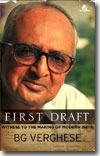|
Home |
Bury the Past and Move OnThe bigger “India story” must not be derailed by religious or factional disputes. And now at Ayodhya, it appears all sides have won. By B G Verghese Deccan Herald, 4 October, 2010 Wise words were spoken this past week. Sometimes we are so filled with anger and bitterness over the perceived wrongs of history that, enveloped in fog, we see the past but dimly and are unable to recognise the future. On the eve of the long-awaited Ayodhya verdict of the Allahabad High Court on September 30, there were appeals for calm all round as the future interrogated the past. Home Minister Chidambaram saw “The India Story” as much more than a dispute over a piece of land” that must not derail “the bigger story”. Young people born after the Babri demolition had moved on and were animated by a very different world view. Even the most ardent contestants have thus far largely responded constructively to an unexpected but remarkable judgement. The verdict has steered a path between faith, history, practice and possession to open a door to a harmonious settlement and reconciliation. The two-to-one majority ruling is that a mosque was not built by demolishing a temple on Babar’s orders, but was erected on the site of a ruined Hindu structure whose provenance as a temple is contested. Hence the property be now divided with a third going each party: to the Hindus (the land under the former central dome where the idols lie), the Muslims (within the inner courtyard) and the Nimrohi Akhara (within the outer courtyard where the Ram Chabutra and Sita ki Rasoi are located). The critical finding, articulated by Justice S.U. Khan is that for centuries, and long before the matter became subject to litigation, Hindus and Muslims had in a real sense shared and indeed worshipped alongside one another within the same disputed premises. If then, why not again now is the unspoken premise of the majority judgment. The judgement has been criticized by some scholars as being based on unproven historical evidence advanced by the Archaeological Survey which allegedly drew unfounded conclusions from site diggings. Others have expressed concern that the Court has departed from historical facts and legal processes to affirm certitudes based on faith. This is not quite so. Justice Khan clearly says that it was only after the mosque was built that Hindus began to identify it with Ramjanamsthan while Justice Agarwal ascribes the area under what was the masjid’s central dome as the Ramjanamsthan only as “per faith and belief of the Hindus”. His observation is descriptive, not juristic. Justice Khan further makes it plain that “As far as the title suit of a civil nature is concerned, there is no room for historical facts and claims”, including claims based on faith. Only Justice Sharma took the line that faith renders the spot where the idols now lie as the Ramjanamsthan, a juristic person and a deity. It would appear that there will be an appeal to the Supreme Court but only after the High Court’s prescribed three month cooling off period, during which the status quo will be maintained. It does not follow that any last minute compromise sought prior to the verdict precludes attempts at a compromise today despite initial statements to the contrary. This is because the parties now confront an entirely new situation. Earlier, the judgement was not known. Now with each side having got a third part of the land under dispute, an appeal could conceivably declare in favour of one party or the other. Half a loaf being better than no bread, there is now reason to be more compromising than before. Whether a compromise will in fact be reached is another matter. But the prospect of a negotiated settlement might now appear relatively more attractive. Meanwhile, the criminal act of deliberately destroying the Babri Masjd on December 6, 1992 cannot be forgotten. The Liberhan Commission has framed the charges. The guilty must be tried and punished expeditiously, unlike what happened when the idols were conspiratorially planted under the central dome of the Masjid on a cold December night in 1949. Justice in this separate but adjunct matter is essential to bring closure to the Mandir-Majid dispute that has dragged on for centuries. Something of the Bigger Story Chidambaram mentioned was manifest on the morning of the judgement when the Prime Minister inaugurated the monumental Unique Identification Number Aadhar programme in a remote Maharashtra village. He handed over a 12-digit number to a poor, unknown farm labourer, Sonawane, making her an identifiable person and an equal citizen of India with rights, privileges, hope and a numbered address that guarantees her a future. Like a hitherto excluded wretch in a song of yore, Sonawane too can proudly proclaim that “I am Somebody, Not a Nobody, Nor just Anybody. And Everybody knows my Name”. Everybody now knows Sonawane as she has a numbered name and address and can no more be treated as a Nobody and fobbed of her rights. That surely marks a revolution ! Sceptics may entertain doubts about the UID solution. But Aadhar will prevail, with millions of Sonawanes marching to a new future under its banner. The road is long; but She now has the means to Overcome. Then, on September 29, the Supreme Court freed a Manipur editor from detention stating that “Any society that would give up a little liberty to gain a little security will deserve neither and lose both”. This principle has wide application. A boisterous, jostling, protesting, growing India confronts a “million mutinies” of multiple transitions by heterogeneous groups fast maturing from tradition to modernity. For such a country, security in many ways comes from and is reinforced by liberty. |
||
| back to the top | |||
HOME | ABOUT THE AUTHOR | LIST OF ARTICLES | CONTACT | BOOKS See also AsianConversations.com 11-C Dewan Shree Apartments, 30 Ferozeshah Rd, New Delhi 110001, India
|


